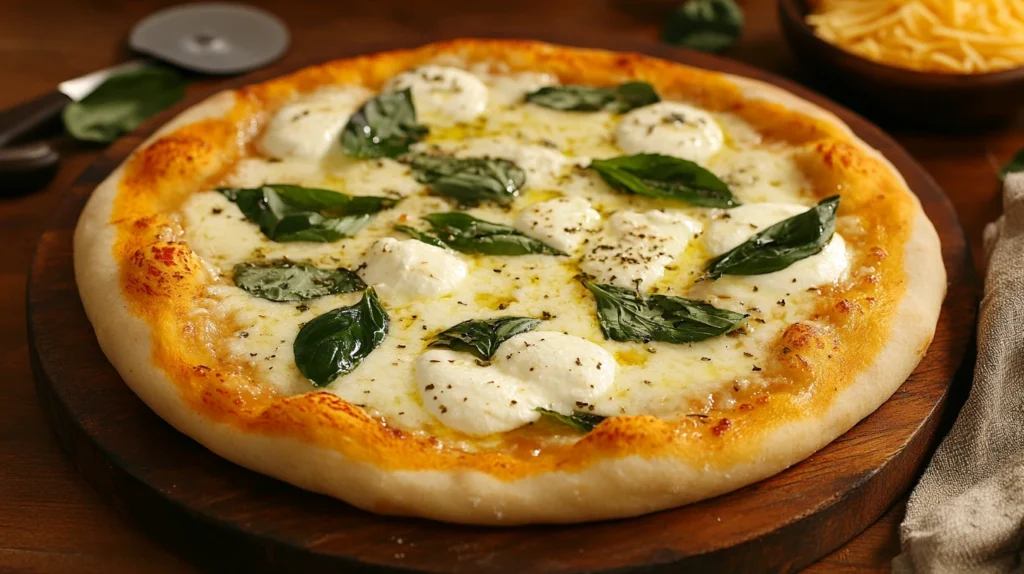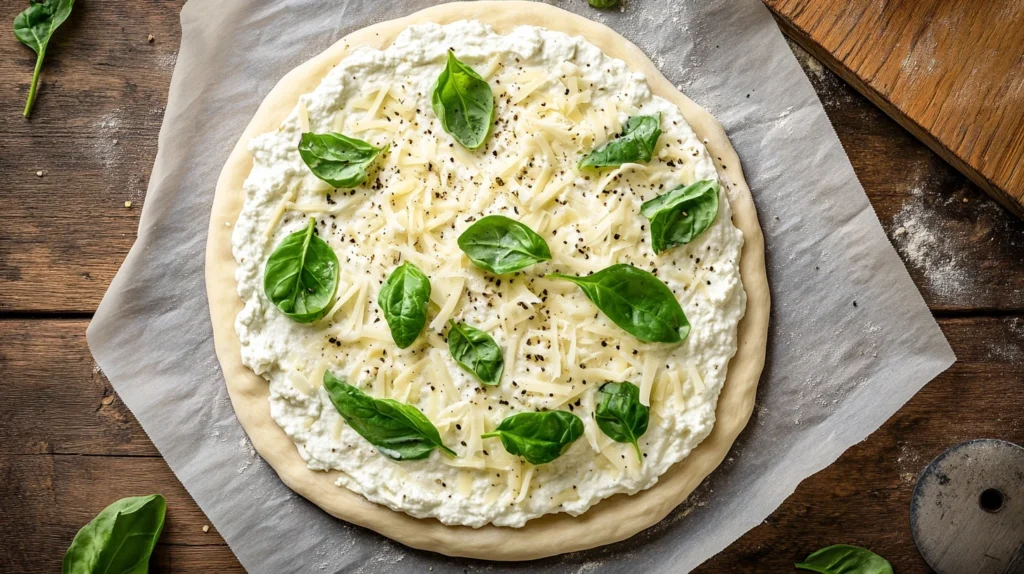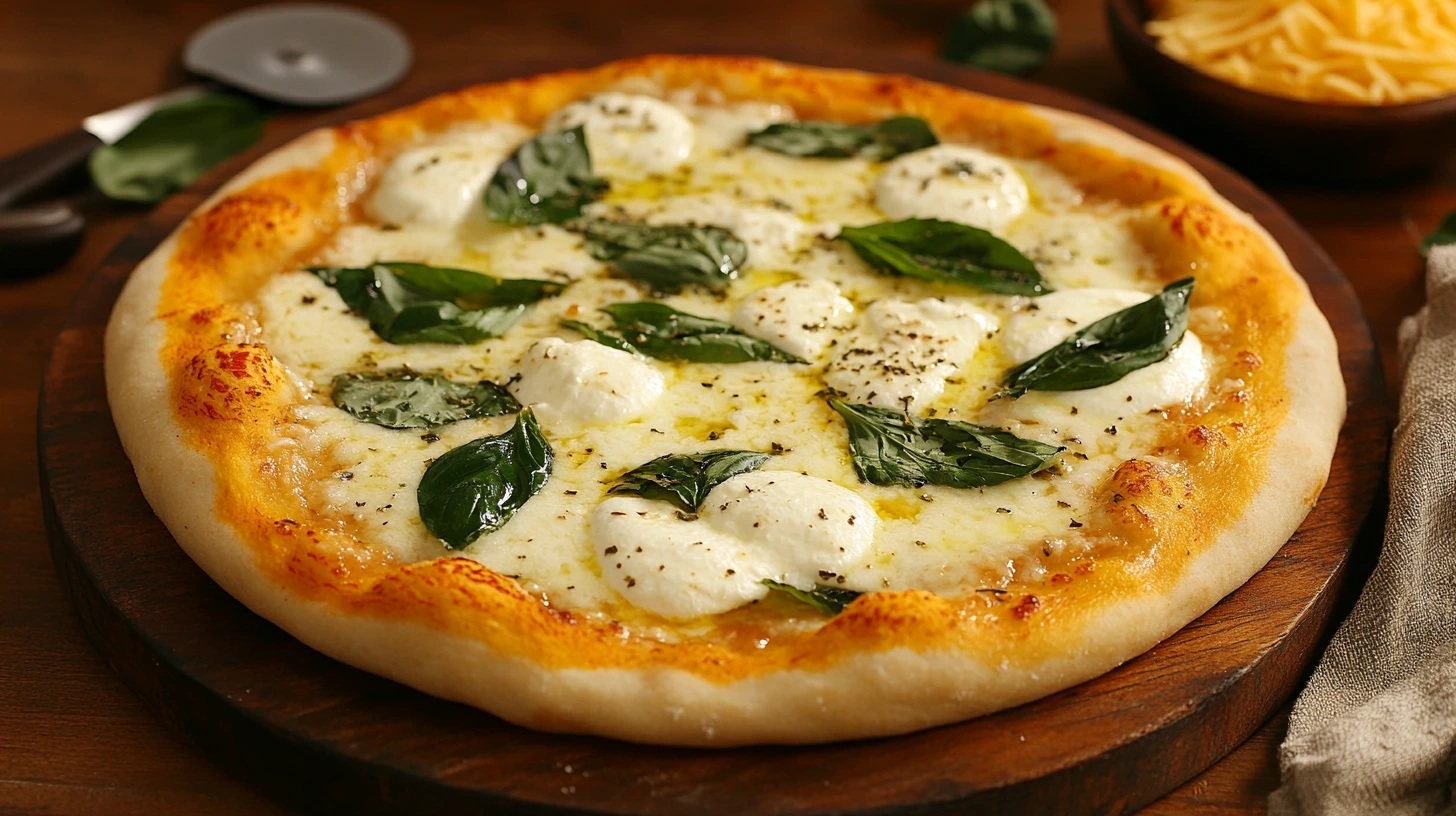White pizza, or “pizza bianca,” is a delightful twist on the classic pizza, replacing the traditional tomato sauce with a rich, creamy base. This dish, rooted in Italian cuisine, is celebrated for its simplicity and versatility. The absence of tomato sauce allows the flavors of the cheese, herbs, and toppings to shine through, making it a favorite for those who love indulgent, cheesy dishes.
Whether you’re a pizza enthusiast looking to try something new or a home chef ready to impress your family and friends, this guide will walk you through creating the perfect white pizza from scratch. From mastering the dough to choosing the best toppings, we’ll cover every detail to help you make a white pizza that rivals any pizzeria’s offering.

Ingredients for White Pizza
The success of any pizza, including white pizza, depends on the quality and combination of its ingredients. Below, we break down the essential components into three main categories: crust, sauce, and toppings. Each element contributes to the final flavor and texture of your pizza.
Crust Ingredients
The crust forms the foundation of your pizza, so choosing the right ingredients is crucial. Here’s what you’ll need for a classic, homemade pizza crust:
- All-purpose flour (3 ½ cups): Provides structure and elasticity to the dough. For a chewier crust, you can substitute bread flour.
- Active dry yeast (1 packet or 2 ¼ tsp): Helps the dough rise and creates a light, airy texture.
- Warm water (1 ¼ cups): Activates the yeast. Ensure it’s warm, not hot, to avoid killing the yeast.
- Olive oil (2 tbsp): Adds flavor and helps achieve a crispy crust.
- Salt (1 tsp): Enhances the overall flavor of the dough.
- Optional: Sugar (1 tsp): Can be added to feed the yeast and aid in browning the crust.
Sauce Ingredients
The white sauce, or “ricotta base,” is the star of this pizza. It’s creamy, garlicky, and perfectly complements the toppings. Here’s what you’ll need:
- Ricotta cheese (1 cup): Acts as the main base for the sauce, offering a smooth, mild flavor.
- Heavy cream (½ cup): Adds richness and ensures the sauce is spreadable.
- Parmesan cheese (¼ cup, grated): Provides a sharp, nutty undertone.
- Garlic (2-3 cloves, minced): Adds depth and a hint of spice.
- Salt and pepper (to taste): Balances and enhances the flavors.
Topping Options
White pizza is highly customizable, allowing you to get creative with toppings. Here are some popular choices to consider:
- Mozzarella cheese (1 ½ cups, shredded): A staple topping for its gooey texture and mild flavor.
- Fresh herbs (basil, oregano, thyme): Add brightness and aroma.
- Spinach (1 cup, fresh or lightly sautéed): A nutritious and colorful addition.
- Mushrooms (½ cup, thinly sliced): Provide an earthy flavor.
- Caramelized onions (½ cup): Add sweetness and complexity.
- Proteins: Grilled chicken, pancetta, or prosciutto for those who want a meatier option.
- Optional: Red pepper flakes: Sprinkle for a hint of spice.
Tools You’ll Need
Making white pizza at home requires some basic kitchen tools to ensure the process is smooth and the results are professional. From mixing the dough to baking the pizza, having the right equipment makes a significant difference in the quality of your final dish.
Mixing Tools
- Mixing bowls: A set of large and medium-sized bowls is essential for preparing and proofing the dough.
- Measuring cups and spoons: Precise measurements are crucial for baking, especially when working with dough.
- Wooden spoon or dough scraper: Helpful for mixing and transferring sticky dough without a mess.
Baking Tools
- Pizza stone or baking steel: These tools help achieve a crispy crust by evenly distributing heat. If you don’t have one, a sturdy baking sheet works as an alternative.
- Rolling pin: For evenly flattening the dough to your desired thickness.
- Parchment paper: Ensures the pizza doesn’t stick to the surface during preparation and baking.
- Pizza cutter or sharp knife: For slicing your freshly baked pizza with ease.
Additional Essentials
- Pastry brush: Useful for brushing olive oil on the crust before baking to enhance its golden color and flavor.
- Grater: For freshly grating parmesan or other hard cheeses.
- Spatula: A wide spatula can help transfer the assembled pizza to the oven without disturbing the toppings.
Now that you have the tools ready, you’re well-equipped to begin crafting your white pizza. In the next section, we’ll dive into the step-by-step process of making your pizza, from preparing the dough to baking it to perfection.
Step-by-Step White Pizza Recipe
Crafting a white pizza involves several stages, from preparing the dough to assembling and baking your pizza. Follow these detailed steps to achieve a restaurant-quality result at home.
Preparing the Dough
The dough is the heart of your pizza. Here’s how to make a perfect crust:
- Activate the Yeast
- In a large mixing bowl, combine warm water (1 ¼ cups) with active dry yeast (2 ¼ tsp). Let it sit for 5-10 minutes until the mixture becomes frothy. This indicates that the yeast is active.
- Mix the Dough
- Add olive oil (2 tbsp), salt (1 tsp), and optional sugar (1 tsp) to the yeast mixture. Slowly incorporate all-purpose flour (3 ½ cups) while stirring with a wooden spoon or dough scraper.
- Knead the Dough
- Transfer the dough to a floured surface and knead for 8-10 minutes until it becomes smooth and elastic. Alternatively, use a stand mixer with a dough hook attachment for 5-7 minutes.
- Proof the Dough
- Place the dough in a lightly oiled bowl, cover it with a clean kitchen towel, and let it rise for 1-2 hours in a warm spot. The dough should double in size.
Crafting the Sauce
The creamy ricotta-based sauce is what makes white pizza unique. Here’s how to prepare it:
- Blend the Ingredients
- In a mixing bowl, combine ricotta cheese (1 cup), heavy cream (½ cup), and grated parmesan cheese (¼ cup). Mix until smooth and creamy.
- Add Seasonings
- Stir in minced garlic (2-3 cloves) and season with salt and pepper to taste. Adjust the thickness with a splash of cream if necessary.
- Chill the Sauce
- Let the sauce rest in the refrigerator while you prepare the toppings and dough. This helps the flavors meld together.
Assembling the Pizza
Now comes the fun part—assembling your pizza:
- Preheat the Oven
- Set your oven to 475°F (245°C) and place a pizza stone or baking steel inside to heat up. If using a baking sheet, preheat it in the oven as well.
- Roll Out the Dough
- Divide the dough into two equal portions for two medium pizzas. Roll each portion out on a floured surface to your desired thickness, about ¼ inch for a thinner crust.
- Prepare the Base
- Place the rolled dough on a piece of parchment paper. Brush the edges with olive oil for a golden crust.
- Spread the Sauce
- Using a spoon or spatula, evenly spread a thin layer of the ricotta sauce over the pizza base, leaving a 1-inch border around the edges.
- Add Toppings
- Start with shredded mozzarella cheese (1 ½ cups), then layer your chosen toppings, such as spinach, mushrooms, and caramelized onions.

Baking Instructions
- Transfer to the Oven
- Carefully slide the pizza (with the parchment paper) onto the hot pizza stone or baking sheet.
- Bake the Pizza
- Bake for 10-12 minutes or until the crust is golden and the cheese is bubbly. Rotate the pizza halfway through for even cooking.
- Cool and Slice
- Remove the pizza from the oven and let it cool for a couple of minutes. Slice with a pizza cutter and serve warm.
Tips for the Perfect White Pizza
Making a great white pizza is about balancing flavors, achieving the right texture, and experimenting with customization. These expert tips will help you elevate your pizza-making skills and create a truly memorable dish.
Choosing Quality Ingredients
- Fresh Cheese
- Use high-quality mozzarella and ricotta cheese for the best flavor and texture. Fresh mozzarella melts better and has a creamier consistency than pre-shredded varieties.
- Seasonal Produce
- Opt for seasonal vegetables like spinach, arugula, or mushrooms for vibrant flavors. Fresh toppings make a noticeable difference in the overall taste.
- Olive Oil Matters
- A good-quality extra virgin olive oil enhances the crust and adds a subtle, fruity aroma.
Adjusting the Recipe
- Dietary Preferences
- For a dairy-free version, replace ricotta and mozzarella with plant-based cheese alternatives. Cashew cream can also be used as a white sauce substitute.
- Gluten-free pizza dough can be made using gluten-free flour and xanthan gum for elasticity.
- Flavor Enhancements
- Add a pinch of nutmeg or lemon zest to the ricotta sauce for extra depth.
- Sprinkle a little truffle oil over the finished pizza for a luxurious touch.
- Portion Control
- Divide the dough and toppings into personal-sized pizzas for better portion management and individual customization.
Baking Tips
- Use a Hot Oven
- A high oven temperature of 475°F (245°C) ensures a crispy crust and perfectly melted cheese. Preheat the pizza stone or baking sheet for at least 30 minutes for optimal results.
- Avoid Overloading
- Resist the temptation to overload the pizza with too many toppings. A balanced topping-to-crust ratio ensures even cooking and prevents sogginess.
- Experiment with Baking Times
- If you prefer a softer crust, bake for 8-10 minutes. For a crispier crust, extend the baking time by 2-3 minutes.
Presentation and Serving
- Fresh Herbs for Garnish
- Sprinkle fresh basil or oregano leaves on the pizza just before serving for a burst of color and aroma.
- Pairing Suggestions
- Serve white pizza with a light salad, such as arugula with lemon vinaigrette, or a bowl of tomato soup for a complementary flavor contrast.
- Pair with a crisp white wine or sparkling water for a refreshing dining experience.
These tips will help you refine your pizza-making technique and customize the recipe to suit your taste preferences.
Related Recipes
Love experimenting with new dishes? Check out these related recipes on Diverse Recipe:
- Smoked Meatloaf Recipe for a hearty and flavorful comfort food.
- Red Velvet Cookies Recipe if you’re in the mood for something sweet after your meal.
- Pepperoni Pizza Guide for a classic pizza night alternative.
Frequently Asked Questions (FAQs)
What Does a White Pizza Consist Of?
White pizza, also known as pizza bianca, is a pizza variety that omits traditional tomato sauce. Instead, it uses a creamy, cheese-based sauce such as ricotta or a combination of olive oil and garlic. The base is often complemented with toppings like mozzarella, parmesan, fresh herbs, vegetables, and sometimes proteins like chicken or prosciutto. The focus is on showcasing the flavors of the cheese and toppings without the acidity of tomatoes.
What Toppings Go on a White Pizza?
White pizza is incredibly versatile, and its toppings can vary based on personal preference. Common options include:
- Cheeses: Mozzarella, ricotta, parmesan, fontina, or goat cheese.
- Vegetables: Spinach, mushrooms, artichokes, caramelized onions, roasted garlic, or arugula.
- Proteins: Grilled chicken, pancetta, prosciutto, or bacon.
- Herbs and Spices: Fresh basil, oregano, rosemary, or red pepper flakes.
- Finishing Touches: A drizzle of olive oil, balsamic glaze, or truffle oil can elevate the flavors.
What’s the Difference Between White Pizza and Alfredo Pizza?
The main difference lies in the type of sauce used:
- White Pizza: Typically features a ricotta-based sauce or a simple olive oil and garlic base. Its focus is on creaminess and the natural flavors of the cheese and toppings.
- Alfredo Pizza: Uses Alfredo sauce, which is made with butter, heavy cream, and parmesan cheese. This creates a richer, more indulgent flavor profile.
While both omit tomato sauce, Alfredo pizza leans toward a more decadent taste, while white pizza emphasizes simplicity and versatility.
Can You Substitute Cottage Cheese for Ricotta on Pizza?
Yes, cottage cheese can be a substitute for ricotta in a white pizza recipe, though it will slightly alter the texture and flavor. Cottage cheese is less dense and has a more liquid consistency compared to ricotta, so it’s a good idea to drain excess moisture by pressing it through a fine-mesh strainer or cheesecloth. Blending it in a food processor can also help achieve a smoother consistency closer to ricotta, which is essential for a creamy base in any white pizza recipe.
Conclusion
White pizza is a versatile and delicious twist on the classic tomato-based pizza, making it a favorite for those looking for a creamy, cheesy alternative. This white pizza recipe starts with simple homemade dough, followed by a rich ricotta-based sauce, and ends with your favorite toppings to create a dish that is both satisfying and adaptable for any occasion.
With the tips and techniques shared in this white pizza recipe, you’ll be able to craft a dish that rivals offerings from your favorite pizzeria. Whether you stick to traditional toppings like mozzarella and fresh herbs or experiment with unique flavors such as caramelized onions and truffle oil, this recipe will help you unleash your culinary creativity.
Pair this white pizza recipe with a crisp salad or hearty soup for a complete and balanced meal. Don’t hesitate to reheat leftovers using the provided methods to maintain their quality. This recipe is not just about making a pizza; it’s about creating a memorable experience you can share with loved ones at your next pizza night.
By following this detailed white pizza recipe, you’ll perfect the art of making a creamy, cheesy pizza at home. So roll up your sleeves, gather your ingredients, and get ready to impress with your homemade white pizza!

